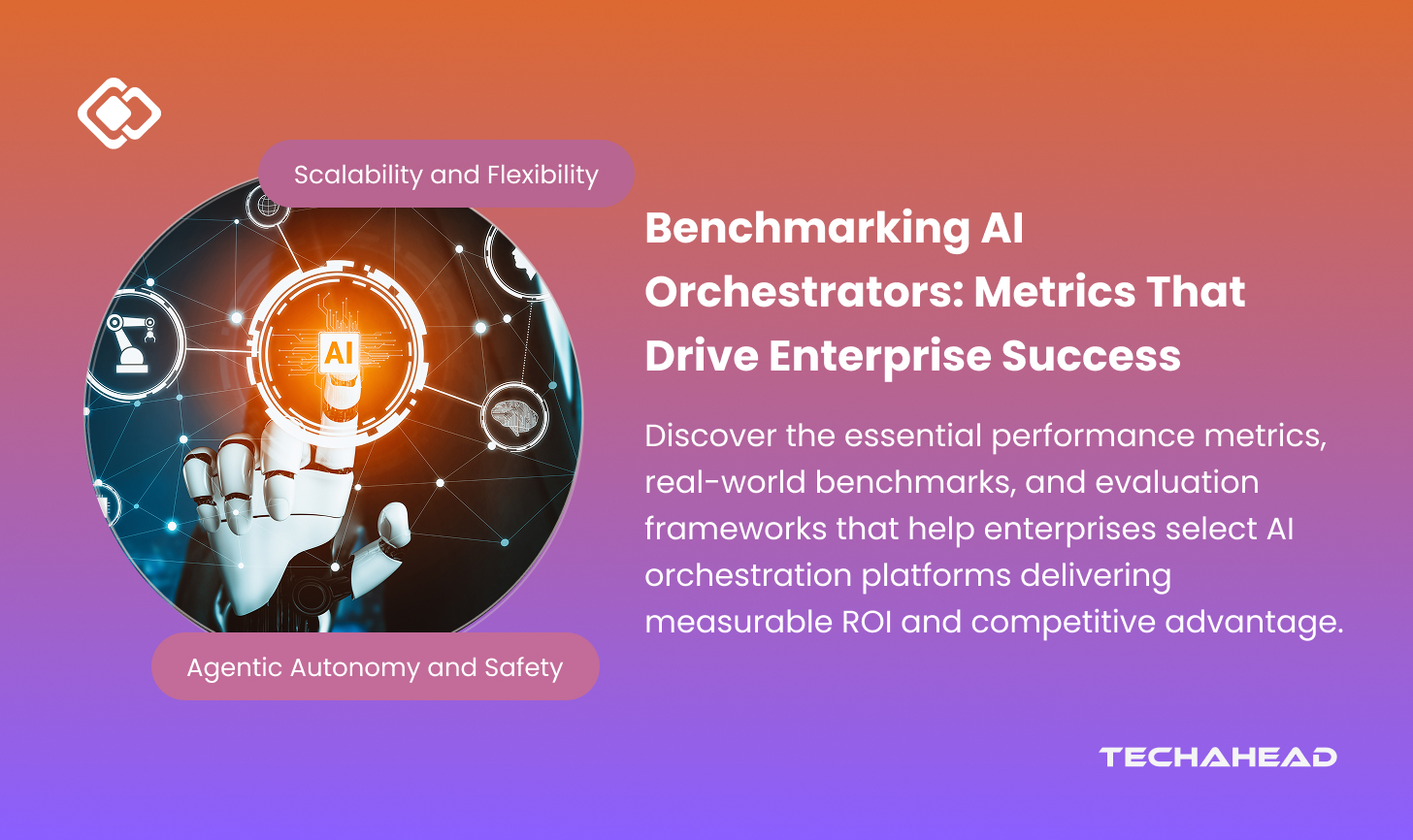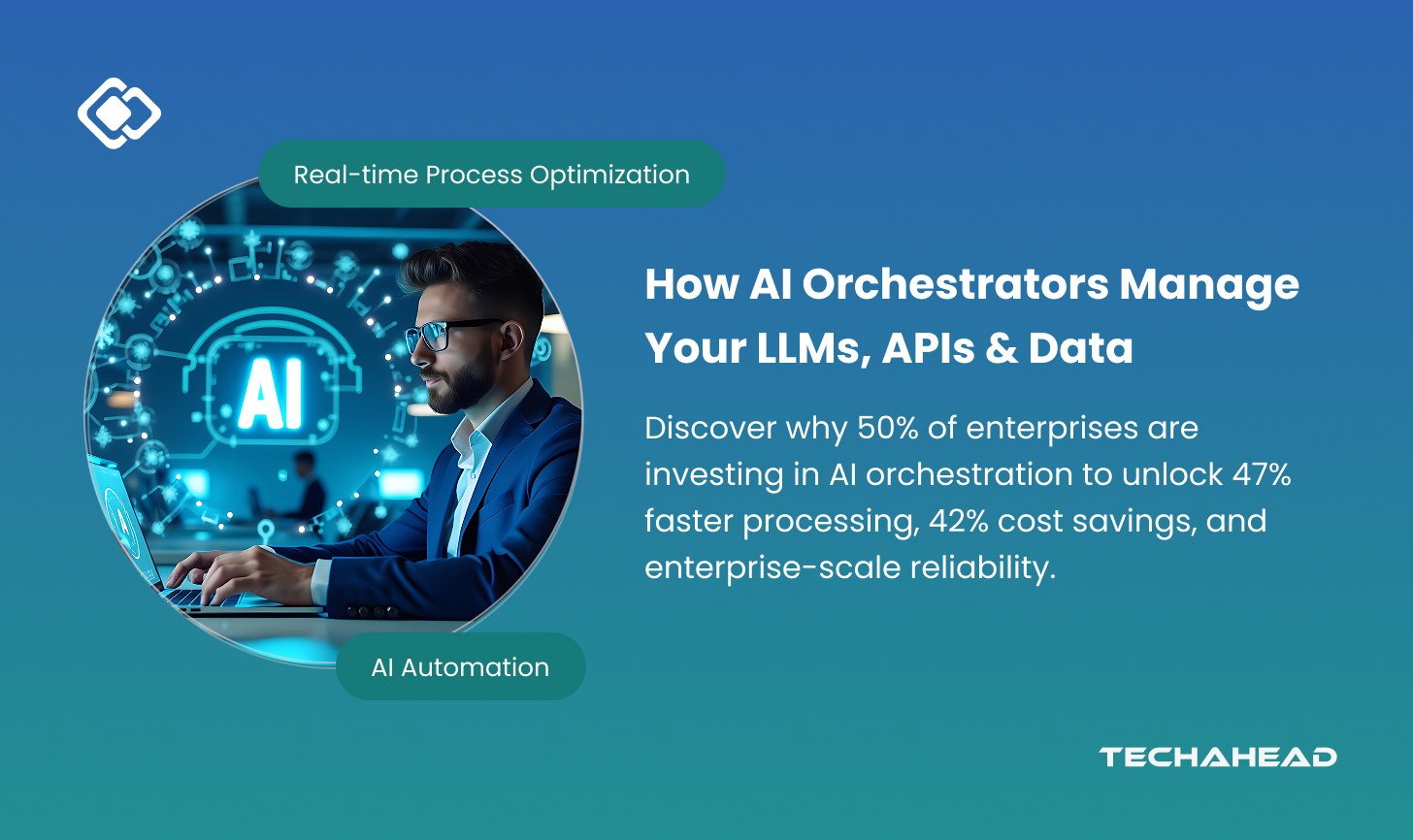The AI ecosystem has exploded in the last couple of years: Organizations are deploying AI agents, AI models, and complex AI systems powered by agents and bots to execute different tasks and requirements.
Here, the prominent question is: How do we ensure that the AI systems created for business processes work in harmony, efficiently, and effectively?
The answer is: AI Orchestration.
As enterprises shift from isolated experiments to complex AI ecosystems, the need for AI Orchestration has become prominent. When it comes to sophisticated coordination, AI Orchestration is the solution enterprises need.
Key Takeaways
- AI orchestration coordinates multiple systems into cohesive workflows solving complex business problems effectively.
- Phased implementation reduces risk while progressively building orchestration capabilities across the organization systematically.
- Architecture choices between hierarchical/decentralized and reactive/proactive systems significantly impact business outcomes.
- Real-world implementations demonstrate 25-60% efficiency gains, 20-40% cost reductions, quality improvements measurably.
- Governance and security must be foundational, not afterthoughts, ensuring compliance and stakeholder trust.
- Leverage proven platforms like LangChain and AutoGen rather than building orchestration from scratch.
And we have numbers to prove it..
As per various market research, it has been revealed that the global AI Orchestration market will swell to mindboggling $10 billion by the end of 2025, and then triple to $30 billion by 2030.
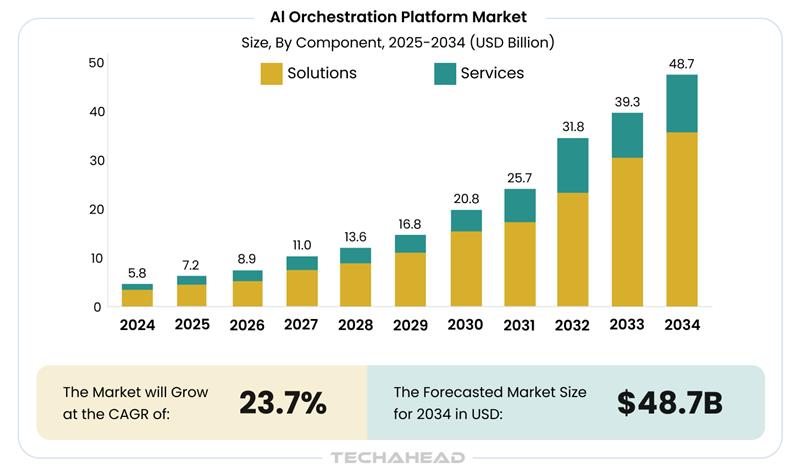
As more and more organizations demand ROI from their AI investments, the need for AI Orchestration has tremendously increased.
In this blog, we will decode AI Orchestration for decision-makers and founders who are in search of an AI process that not only handles complex AI platforms but also ensures maximum return from their investments.

In layman’s terms, this blog is a blueprint, a roadmap for designing multi-agent systems that deliver measurable value at enterprise scale.
Let’s dive in!
What is AI Orchestration?
Think of AI orchestration as the conductor of a symphony orchestra.
Just as a conductor coordinates musicians playing different instruments to create harmonious music, AI orchestration manages and coordinates multiple AI systems, agents, and models to work together seamlessly toward common business objectives.
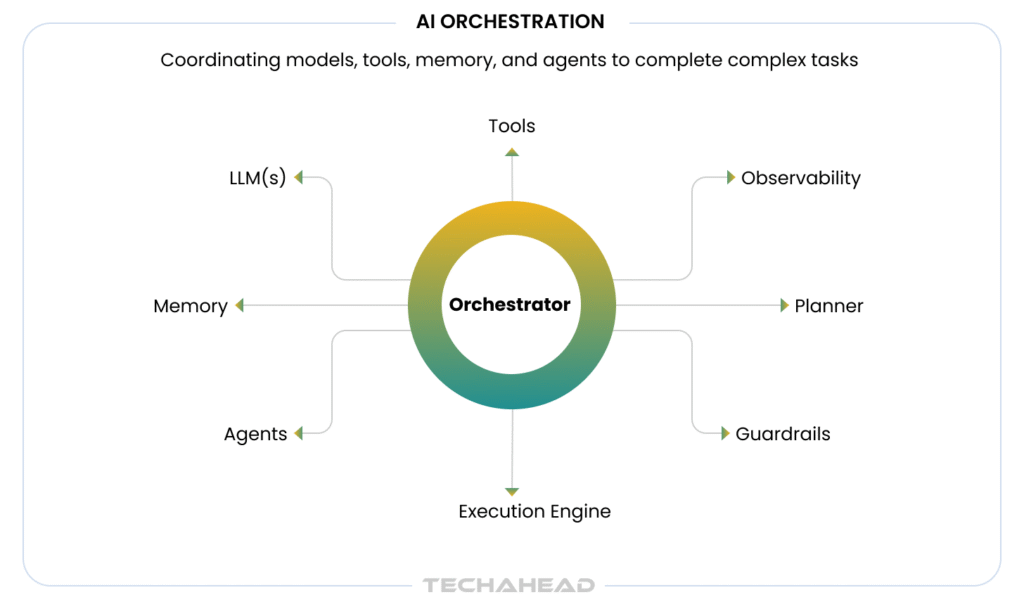
At its core, AI orchestration is the practice of integrating, automating, and managing diverse AI components, ranging from large language models and machine learning algorithms to robotic process automation and decision engines, and merging them into cohesive workflows that solve complex business problems.
The need for orchestration has intensified as enterprises move beyond single-purpose AI applications. Modern organizations often run dozens of AI models simultaneously: customer service chatbots, predictive analytics engines, document processing systems, fraud detection algorithms, and more.
Without AI orchestration, these systems operate in silos, duplicating efforts, creating data bottlenecks, and failing to deliver their full potential.
Key components of AI Orchestration
Integration
Connecting disparate AI systems, data sources, and business applications through standardized interfaces and protocols.
Automation
Streamlining workflows by automatically routing tasks between agents, triggering actions based on conditions, and managing resource allocation without constant human intervention.
Management
Monitoring performance, ensuring governance compliance, optimizing resource utilization, and maintaining system health across the entire AI ecosystem.
Why Enterprises Need AI Orchestration
The explosion of AI adoption has created unprecedented complexity. Research indicates that 80% of organizations struggle with AI deployment challenges, despite significant investments in technology and talent. The gap between AI potential and realized value stems largely from fragmented implementations that lack coordination.
Enterprises face tangible challenges without proper orchestration:
Resource waste: Multiple teams independently developing similar AI capabilities, duplicating infrastructure costs and engineering efforts.
Latency issues: Manual handoffs between systems create delays that undermine real-time decision-making requirements.
Poor ROI: AI projects failing to scale beyond proof-of-concept stages, with benefits confined to isolated departments rather than flowing across the organization.
Scalability risks: Systems that perform well in controlled environments break down under production loads or fail to adapt to changing business needs.
Governance gaps: Lack of visibility into AI decision-making processes, creating compliance risks and eroding stakeholder trust.
Conversely, effective AI orchestration delivers strategic benefits that directly impact the bottom line. Organizations implementing orchestration frameworks report higher operational efficiency through automated workflows that eliminate manual bottlenecks.
Cross-team synergy improves as different departments leverage shared AI capabilities rather than building redundant systems. Customer experiences become more cohesive when AI agents across touchpoints share context and coordinate responses.
System resilience strengthens as orchestration platforms automatically detect failures, reroute tasks, and maintain business continuity.
Core Components & Architecture
Understanding the building blocks of AI orchestration helps enterprises design systems aligned with their specific requirements and constraints.
Agent Frameworks: These provide the foundation for creating, deploying, and managing individual AI agents. Modern frameworks like LangChain, AutoGen, and CrewAI offer pre-built components for common agent patterns, reducing development time while ensuring consistency across implementations.
Data Pipelines: Orchestration requires seamless data flow between agents and systems. Enterprise-grade pipelines handle data ingestion from multiple sources, transformation into formats required by different models, and distribution to downstream consumers. These pipelines must support both batch processing for analytical workloads and real-time streaming for operational use cases.
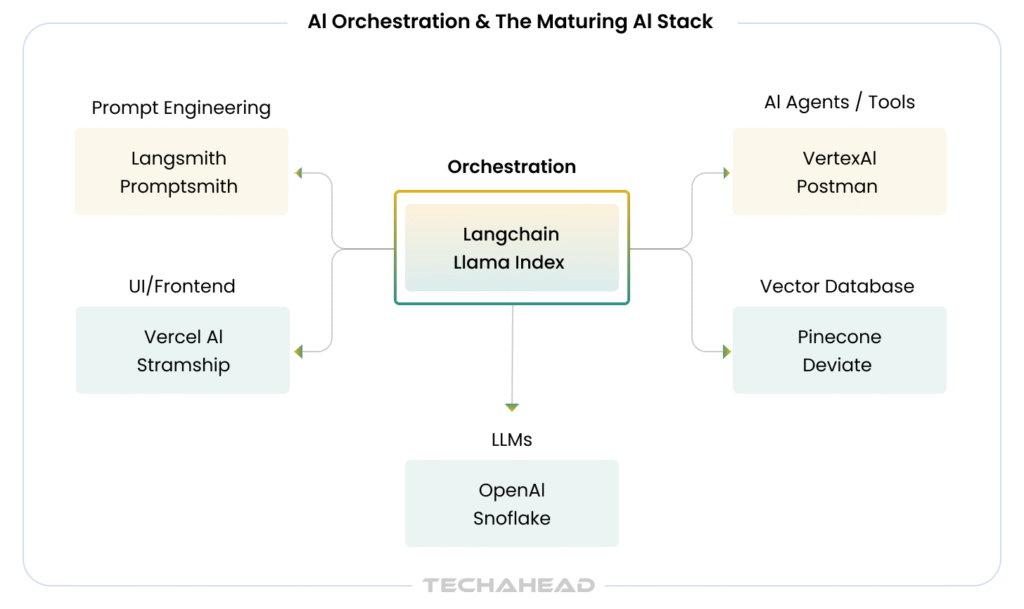
Integration Layers and APIs: Standard interfaces enable heterogeneous AI systems to communicate effectively. RESTful APIs, message queues, and event-driven architectures allow agents built on different platforms to exchange information, trigger workflows, and coordinate actions without tight coupling.
Automated Workflow Engines: These orchestrate complex sequences of AI tasks, managing dependencies, handling parallel execution, and implementing business logic that determines how agents collaborate. Workflow engines track state, manage retries for failed operations, and ensure transactional consistency across distributed operations.
Governance and Monitoring Dashboards: Enterprise orchestration demands visibility into system behavior. Comprehensive dashboards track performance metrics, audit agent decisions, detect anomalies, and provide alerts when intervention is required. These tools are essential for maintaining compliance, troubleshooting issues, and optimizing resource allocation.
Leading technology providers like IBM and UiPath have published reference architectures showing how these components fit together.
A typical enterprise orchestration architecture features a central control plane managing multiple agent pools, with each pool specialized for different business functions.
Data flows through secure pipelines, while API gateways handle authentication, rate limiting, and request routing. Monitoring systems collect telemetry from all components, feeding dashboards and automated alerting systems.
Key Architectural Concepts of AI Orchestration
Observability: The ability to understand system state by examining outputs, essential for debugging complex multi-agent interactions and ensuring transparency.
Policy Management: Centralized definition and enforcement of rules governing agent behavior, data access, and resource utilization.
Cross-Agent Collaboration: Mechanisms enabling agents to share context, negotiate task assignments, and coordinate activities without creating tight dependencies that limit flexibility.
Types of Multi-Agent AI Systems
Multi-agent architectures fall into distinct categories, each suited to different enterprise scenarios and technical requirements.
Reactive versus Proactive Systems
Reactive multi-agent systems respond to specific triggers or requests, executing predefined workflows when conditions are met. A customer service scenario might trigger a reactive system when a support ticket arrives, routing it through agent pipelines for categorization, research, and response generation. Proactive systems continuously monitor their environment, identifying opportunities and initiating actions autonomously.
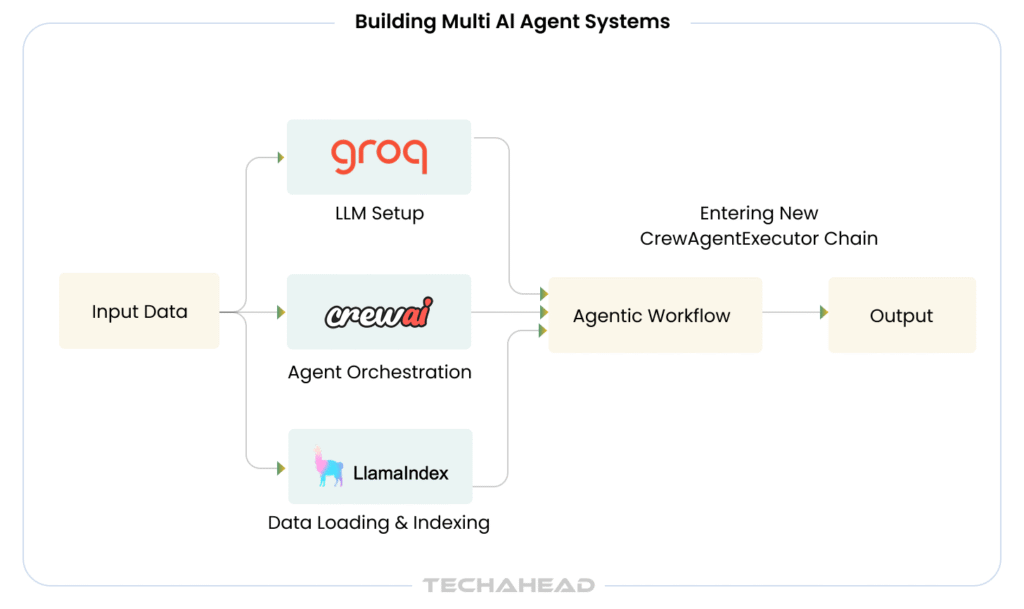
A proactive system might detect patterns in customer behavior that signal churn risk, automatically launching retention campaigns before explicit requests.
Hierarchical versus Decentralized Architectures
Hierarchical systems employ a central controller or orchestrator that manages task distribution, monitors progress, and coordinates agent activities.
This approach simplifies governance and ensures consistency but creates potential bottlenecks and single points of failure. Hierarchical architectures work well for enterprise scenarios requiring strong oversight, such as financial transaction processing or regulated healthcare workflows.
Decentralized systems distribute decision-making across peer agents that negotiate, collaborate, and self-organize without central authority. This peer-to-peer approach offers greater scalability and resilience, as there is no central bottleneck, but it introduces complexity in ensuring consistency and coordinating conflicting objectives.
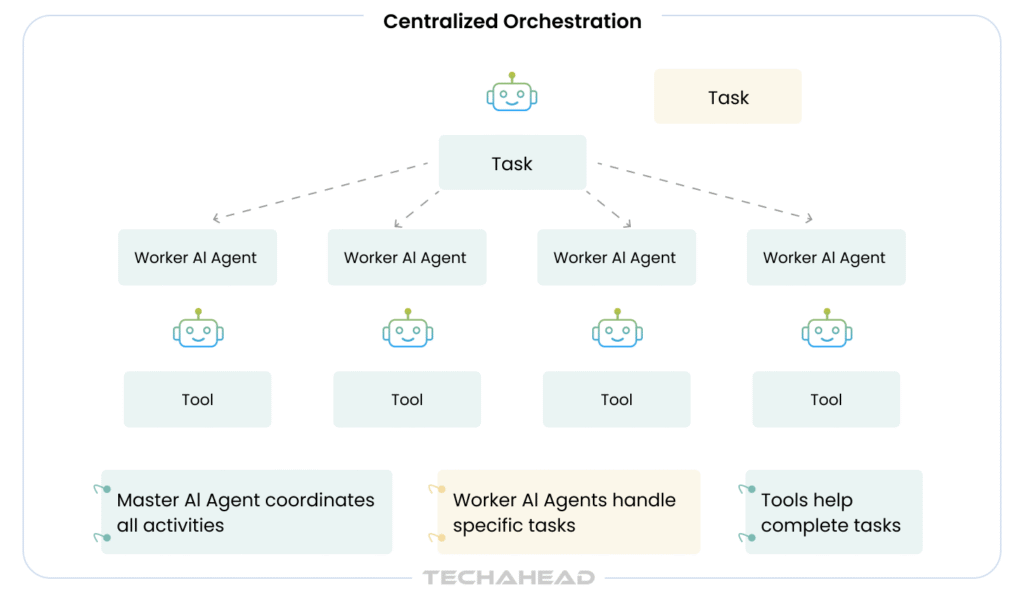
Decentralized architectures suit scenarios like distributed data processing, where autonomous regional systems must coordinate while maintaining local control.
Enterprise Deployment Scenarios for Different Architectures
Enterprise Data Search
Hierarchical reactive systems excel here, with a central orchestrator receiving search queries, dispatching specialized agents to different data sources, aggregating results, and presenting unified responses.
Customer support
Hybrid approaches combining hierarchical oversight with decentralized agent pools handle variable loads effectively, with central routing managing overall workflow while autonomous agent teams handle specific interactions.
Operations Automation
Proactive decentralized systems monitor operational metrics, detect anomalies, and coordinate remediation across distributed infrastructure without requiring constant human oversight.
Research and development: Decentralized proactive systems enable experimentation at scale, with autonomous agents exploring solution spaces, sharing discoveries, and converging on optimal approaches through collaborative iteration.
Practical Business Use Cases Of AI Orchestration
Real-world implementations demonstrate the tangible value of AI orchestration across industries.
Microsoft’s AutoGen Implementation
Microsoft has documented reducing AI development costs by 30% and accelerating deployment speed by 25% through AutoGen orchestration tools. Their implementation enables developers to construct multi-agent workflows using pre-built components, dramatically reducing the expertise required to create sophisticated AI systems. The orchestration framework automatically manages agent interactions, handles error recovery, and optimizes resource allocation, allowing Microsoft teams to focus on business logic rather than infrastructure complexity.
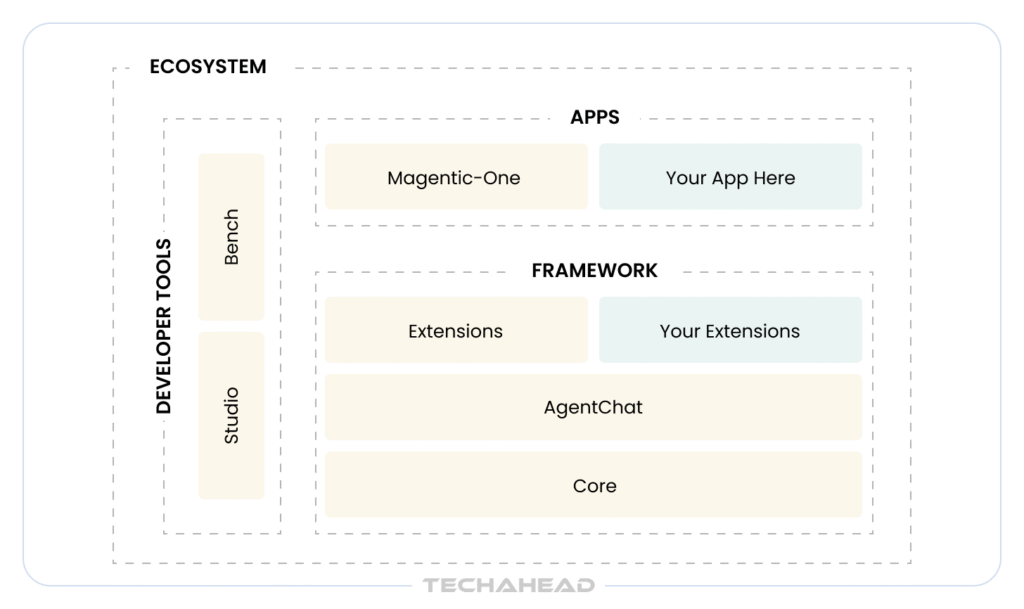
Leading AI Orchestration Platforms
| Platform | Best For | Key Strengths | Enterprise Adoption | Licensing |
| LangChain | LLM-based workflows | Extensive integrations, active community, rich ecosystem | High – used by Uber, Notion | Open-source + Enterprise |
| AutoGen | Multi-agent conversations | Microsoft backing, strong debugging tools, conversational AI | Growing – Microsoft internal use | Open-source |
| SuperAGI | Autonomous agents | Infrastructure for long-running agents, resource management | Emerging – early adopters | Open-source |
| CrewAI | Role-based teams | Intuitive agent collaboration patterns, workflow templates | Moderate – startups/mid-market | Open-source + Cloud |
| LangGraph | Complex state management | Graph-based workflows, sophisticated control flow | Growing – technical teams | Open-source |
Uber’s LangChain Orchestration
Uber reported cutting AI model training time by 50% while improving accuracy by 15% using LangChain orchestration frameworks. Their system coordinates multiple specialized models for demand prediction, pricing optimization, and route planning. The orchestration layer automatically selects appropriate models based on data characteristics, manages feature engineering pipelines, and combines predictions from multiple models to improve overall accuracy. This coordinated approach delivers better results than isolated models while reducing computational costs.
Smyth OS Multi-Agent Customer Experience
Smyth OS achieved a 40% increase in customer satisfaction scores and 20% reduction in support costs through multi-agent orchestration.
Their system deploys specialized agents for different customer service tasks: sentiment analysis, knowledge retrieval, response generation, and quality assurance. Orchestration ensures seamless handoffs between agents, maintains conversation context, and escalates complex issues to human operators when necessary.
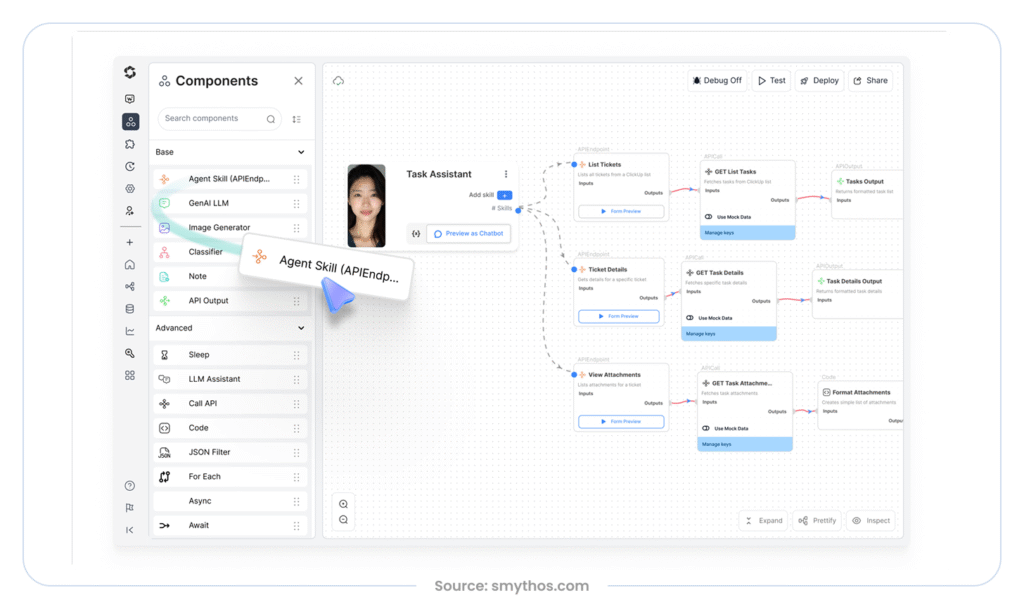
SmythOS Workflow with AI Orchestration: Source
The coordinated approach delivers faster, more accurate responses while freeing human agents to handle cases requiring empathy and judgment.
Banking Loan Approval Workflows
Major financial institutions have implemented orchestrated multi-agent systems for loan processing, achieving approximately 60% productivity improvements.
These systems coordinate agents handling document verification, credit scoring, fraud detection, regulatory compliance checking, and risk assessment.
Orchestration ensures all steps are completed in the correct sequence, automatically routes exceptions to appropriate specialists, and maintains audit trails for regulatory compliance. Processing times have dropped from days to hours while maintaining rigorous risk standards.
Retail Predictive Supply Chain
Leading retailers deploy orchestrated multi-agent systems combining demand forecasting, inventory optimization, logistics planning, and pricing models.
These systems continuously analyze sales data, weather patterns, social media trends, and competitor pricing to optimize inventory levels and prevent stockouts.
The orchestration layer coordinates decisions across agents to balance conflicting objectives like minimizing inventory costs while maximizing product availability, delivering measurable improvements in margins and customer satisfaction.
Step-by-Step Guide to Designing Multi-Agent Systems
Successful AI orchestration requires methodical planning and phased implementation that balances ambition with pragmatism.
Strategic Foundations
Begin by clearly defining the business problems orchestration will solve. Avoid technology-first thinking that implements orchestration for its own sake. Instead, identify specific pain points: Are manual handoffs between systems creating delays? Are redundant AI investments consuming budget without delivering proportional value? Are governance gaps creating compliance risks?
Choose process domains carefully for initial implementation. Look for workflows that are important enough to justify investment but contained enough to manage complexity. Customer onboarding, order fulfillment, and helpdesk operations often provide good starting points, offering measurable business value without requiring integration across the entire enterprise.
Set concrete orchestration goals with measurable success criteria. Rather than vague objectives like “improve AI effectiveness,” define specific targets: reduce average handling time by 30%, decrease escalation rates by 40%, or improve first-contact resolution by 25%. These concrete goals guide design decisions and provide clear benchmarks for evaluating success.
Phased Implementation Roadmap
Phase 1 – Foundation (Months 1-6)
Establish the groundwork for orchestration by addressing data infrastructure, APIs, and simple workflow agents. Audit existing data sources and create unified access layers that provide consistent interfaces regardless of underlying systems. Implement basic APIs enabling inter-system communication. Deploy initial single-purpose agents handling discrete tasks like document classification or data extraction. The goal is proving basic concepts while building infrastructure for more sophisticated orchestration.
Phase 2 – Orchestration (Months 7-12)
Adopt standardized frameworks like LangGraph, SuperAGI, or AutoGen rather than building custom orchestration from scratch. These proven frameworks accelerate development while incorporating best practices learned from thousands of implementations. Implement centralized monitoring capturing telemetry from all agents and workflows. Design secure architecture addressing authentication, authorization, data encryption, and audit logging. Begin connecting multiple agents into coordinated workflows solving end-to-end business processes.
Phase 3 – Collaboration (Months 13-18)
Scale beyond simple workflows into multi-agent teams handling complex scenarios requiring dynamic coordination. Implement robust topologies that maintain performance as agent counts increase.
Define clear communication protocols standardizing how agents share information, negotiate task assignments, and resolve conflicts. Introduce sophisticated failure recovery mechanisms that automatically detect issues, reroute work, and maintain business continuity without human intervention.
Phase 4 – Autonomy (Months 19-24+)
Evolve toward closed-loop systems where agents monitor their own performance, identify improvement opportunities, and adapt behaviors without explicit programming changes. Implement digital twin concepts creating virtual representations of physical processes, enabling simulation, optimization, and predictive maintenance. Establish mature human-in-the-loop oversight where people define guardrails and handle exceptions rather than managing routine operations.
Key Design Decisions For Creating AI Orchestration
Topology
Determine the overall structure connecting agents. Star topologies with a central hub suit hierarchical control. Mesh topologies where agents connect peer-to-peer enable decentralized coordination. Hybrid approaches balance control and flexibility.
Agent Roles
Define clear responsibilities for each agent type. Specialization improves performance but increases coordination complexity. Finding the right balance depends on your specific requirements.
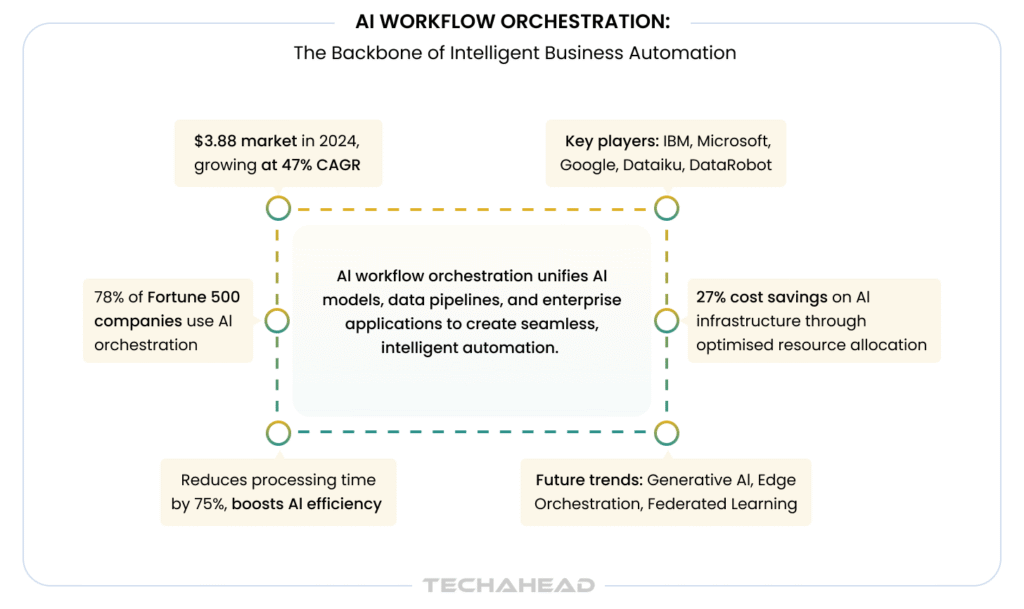
Hand-off Mechanisms
Specify how agents transfer work between each other. Synchronous hand-offs wait for completion before proceeding, ensuring consistency but potentially reducing throughput. Asynchronous hand-offs improve performance but require careful state management.
Failure Recovery
Design for inevitable failures. Implement retry logic with exponential backoff, circuit breakers preventing cascade failures, and graceful degradation, maintaining partial functionality when components fail.
Explainability: Ensure orchestration decisions remain interpretable. Log agent reasoning, maintain audit trails showing how conclusions were reached, and provide interfaces for investigating unexpected behaviors.
Integration and Automation Best Practices
Connecting disparate agents and systems requires careful attention to integration patterns and automation strategies.
API-Driven Communication
Design comprehensive APIs providing clean interfaces between components. RESTful APIs work well for synchronous request-response patterns. GraphQL offers flexibility for clients needing specific data subsets. gRPC delivers high performance for internal service-to-service communication.
Regardless of protocol, maintain backward compatibility as systems evolve, implement rate limiting to prevent resource exhaustion, and provide clear documentation enabling teams to integrate effectively.
Orchestration Architecture Comparison
| Architecture Type | Governance | Scalability | Complexity | Best Use Cases |
| Hierarchical Centralized | Excellent – single point of control | Moderate – bottleneck risk | Low – simpler to implement | Regulated industries, financial processing, compliance-critical workflows |
| Hierarchical Distributed | Good – regional control points | Good – horizontal scaling | Moderate – coordination overhead | Global operations, multi-region deployments |
| Decentralized Peer-to-Peer | Challenging – emergent behavior | Excellent – natural distribution | High – consensus mechanisms | Research, distributed processing, resilient operations |
| Hybrid (Recommended) | Good – flexible policies | Excellent – adaptive | Moderate – balanced approach | Most enterprise scenarios, omnichannel experiences |
Event Streaming
Implement event-driven architectures for asynchronous communication and real-time data distribution. Platforms like Apache Kafka or AWS Kinesis enable agents to publish events that other components consume, creating loosely coupled systems that scale independently.
Event streaming supports complex workflows where multiple agents react to the same trigger, enables real-time analytics on system behavior, and facilitates integration with external systems.
Automated Model Selection and Deployment
Implement orchestration logic that automatically selects appropriate AI models based on task characteristics, data availability, latency requirements, and cost constraints. Create deployment pipelines that test models in staging environments, gradually roll out to production traffic, and automatically roll back if performance degrades. This automation accelerates innovation cycles while maintaining production stability.
Resource Management
Orchestration platforms must manage computational resources effectively across multiple agents and workloads. Implement auto-scaling that adjusts capacity based on demand, preventing both resource waste during quiet periods and performance degradation during peaks.
Use containerization and orchestration platforms like Kubernetes to efficiently pack workloads onto available infrastructure. Monitor resource utilization continuously, identifying optimization opportunities and cost-reduction potential.
Self-Healing Automation
Build systems that detect and recover from failures automatically. Implement health checks monitoring agent availability and performance. Configure automatic restarts for failed components. Design workflows that reroute around unavailable services. Log all failures comprehensively, enabling post-incident analysis and continuous improvement.
Implementation Maturity Stages
| Stage | Key Capabilities | Typical Duration | Business Impact | Risk Level |
| Foundation | Single-domain agents, basic APIs, manual oversight | 3-6 months | 15-25% efficiency gain | Low |
| Orchestration | Cross-domain workflows, automated monitoring, standardized frameworks | 6-12 months | 30-50% efficiency gain | Moderate |
| Collaboration | Multi-agent teams, advanced topologies, self-healing systems | 12-18 months | 50-70% efficiency gain | Moderate-High |
| Autonomy | Closed-loop systems, digital twins, predictive optimization | 18-24+ months | 70-100%+ efficiency gain | High |
Tools, Platforms, and Ecosystem
The AI orchestration ecosystem offers diverse platforms suited to different enterprise requirements and technical preferences.
LangChain has emerged as a leading framework for building LLM-based applications, offering extensive integrations with major model providers, vector databases, and enterprise systems. Its modular architecture enables developers to compose complex workflows from pre-built components while maintaining flexibility for custom requirements. LangChain’s active community contributes connectors, templates, and best practices that accelerate development. Enterprise features include LangSmith for debugging and monitoring.
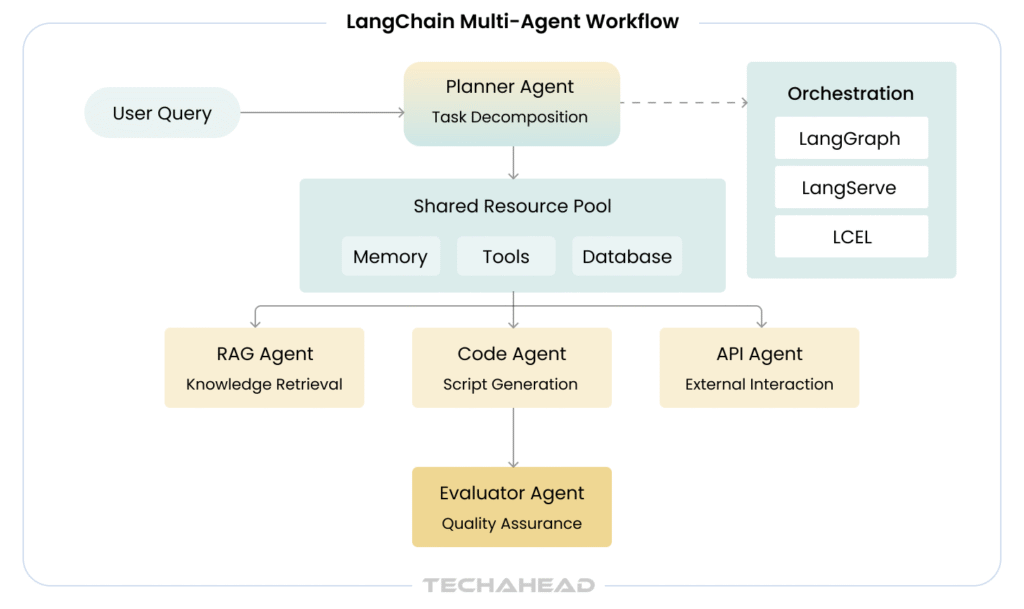
AutoGen, developed by Microsoft Research, specializes in multi-agent conversations where agents collaborate to solve complex tasks. Its strength lies in sophisticated debugging tools that help developers understand and optimize agent interactions. AutoGen supports both fully autonomous agents and human-in-the-loop patterns. Microsoft’s backing provides confidence in long-term support and enterprise readiness.
SuperAGI focuses on infrastructure for long-running autonomous agents that operate continuously rather than handling discrete requests. It provides resource management, persistence, and scheduling capabilities essential for agents that must maintain state over extended periods. SuperAGI suits scenarios like ongoing market research, continuous monitoring, or long-term optimization problems.
CrewAI simplifies multi-agent orchestration by providing intuitive abstractions for role-based agent teams. Developers define agent roles, assign tasks, and specify collaboration patterns using straightforward APIs. CrewAI includes workflow templates for common scenarios, accelerating time-to-value for teams new to multi-agent systems.
LangGraph extends LangChain with graph-based workflow capabilities enabling sophisticated state management and control flow. It excels at complex scenarios requiring conditional logic, loops, and parallel execution paths. LangGraph’s visual workflow representations help teams understand and maintain complex orchestrations.
Organizations should evaluate platforms based on specific requirements, existing technical stacks, team expertise, and long-term strategic direction. Many successful implementations combine multiple frameworks, using each for scenarios where it excels.
Conclusion
AI orchestration represents a fundamental shift in how enterprises approach artificial intelligence: Moving from isolated experiments to integrated systems delivering coordinated value across organizations.
The business case is compelling: proven implementations demonstrate efficiency improvements of 25-60%, cost reductions of 20-40%, and qualitative benefits in customer satisfaction and competitive positioning.
Success requires methodical planning that balances technical sophistication with organizational readiness.
Enterprises should begin with clear business objectives, choose appropriate starting domains, and implement phased roadmaps that build capabilities progressively. Adopting proven frameworks accelerates development while incorporating best practices from thousands of implementations. Prioritizing governance, security, and compliance from the outset prevents costly retrofitting while building stakeholder confidence.
The orchestration ecosystem continues maturing, with standardization efforts, emerging protocols, and innovative approaches like digital twins and compound AI systems expanding what’s possible. Organizations beginning orchestration journeys today position themselves to leverage these advances while competitors struggle with fragmented, inefficient AI deployments.
Actionable recommendations for enterprises considering orchestration:
Start with pilot projects in contained domains offering measurable value and manageable complexity. Customer service, document processing, and operational monitoring provide good entry points. Define concrete success metrics before implementation, ensuring clear benchmarks for evaluating outcomes.
Invest in foundational data infrastructure and APIs before implementing sophisticated orchestration. Many initiatives fail because underlying systems cannot support the integration requirements and orchestration demands.
Build cross-functional teams combining domain expertise, technical capabilities, and governance knowledge. Successful orchestration requires understanding business processes, technical architecture, and regulatory requirements simultaneously.
Watch for risk indicators, including excessive vendor lock-in, insufficient monitoring and observability, inadequate security controls, and over-ambitious timelines that skip foundational work. Address these proactively rather than discovering problems after expensive implementations.
Establish ongoing optimization processes rather than treating orchestration as a one-time project. The most successful organizations continuously refine agent interactions, incorporate feedback, and expand capabilities as they gain experience.
Ready to orchestrate your AI for enterprise-scale? The convergence of proven frameworks, clear best practices, and documented success stories means this is the optimal moment to begin your orchestration journey. Organizations that move decisively will establish competitive advantages that compound over time, while those that delay face increasingly difficult catch-up challenges.
Note: This blog represents the current understanding of AI orchestration practices as of 2025. Technologies and methodologies continue evolving. Consult with qualified experts from TechAhead for guidance on specific implementations.

AI orchestration coordinates intelligent agents that adapt and learn, while traditional automation executes predefined rules. Orchestration handles ambiguity and makes contextual decisions, whereas automation follows fixed logic paths.
Most enterprises require 12-18 months for meaningful orchestration capabilities, with foundational work taking 3-6 months, basic orchestration 6-12 months, and advanced collaboration features 12-18 months to implement properly.
Key risks include unauthorized data access between agents, adversarial attacks manipulating agent decisions, insufficient audit trails preventing accountability, and cascade failures where one compromised agent affects the entire system.
Yes, orchestration platforms integrate with most existing AI systems through APIs and standardized protocols. Legacy systems may require wrapper services providing modern interfaces, but wholesale replacement is rarely necessary.
Successful orchestration requires cross-functional teams, clear governance frameworks, updated security policies, continuous monitoring processes, and executive sponsorship ensuring necessary resources and organizational support throughout implementation.
Track efficiency metrics like processing time reductions, cost metrics including resource utilization improvements, quality metrics such as error rate decreases, and business outcomes like customer satisfaction improvements and revenue impacts.


